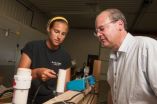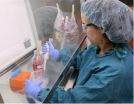Doing the math to fight childhood obesity
Researchers create a new tool for sizing up the impact of anti-obesity policies
2012-08-15
(Press-News.org) Dieters often use online calorie calculators to stay true to their weight-loss plan. Translating the concept to the population health arena, researchers at Columbia University's Mailman School of Public Health created the Caloric Calculator to help policymakers, school district administrators, and others assess the potential impact of health policy choices on childhood obesity.
Select a target population (middle-school-age boys, for example) and the Caloric Calculator tells you the percentage of this group who are obese (18%) and the average daily calorie cuts necessary to meet two goals: returning them to obesity levels for that population in the year 2000 and the early 1970s (109 and 237 kcal, respectively). The user can then choose from a menu of 14 interventions: 30 minutes of daily PE time, for example, would reduce 49 kcal; eliminating one can of soda would cut an additional 136 kcal; and restricting television time by 60 minutes would cut another 106 kcal. Each time an intervention is added, the Calculator displays a graph illustrating the cumulative impact on obesity goals. In this example, both goals are met.
"While childhood obesity can sometimes seem like an insurmountable problem, there are many proven interventions that can make a difference. The Caloric Calculator shows that, when implemented in combination, they add up to what is needed," says Claire Wang, MD, ScD, Assistant Professor in the Department of Health Policy & Management, who led the development of the tool.
While the Caloric Calculator is geared for policymakers, it may also prove useful to parents and teachers who want to be informed about the relative merits of ways to fight childhood obesity in their community.
In developing the Calculator, Dr. Wang and colleagues conducted an extensive review of scientific literature on physical activity, dietary, and other preventive interventions to estimate their impact on children's "energy gap"—the difference between the number of calories consumed each day and the number of calories required to support normal growth and physical activity. Excess weight gain occurs when energy intake exceeds energy expended over a period of time, explains Dr. Wang.
"One of our goals with the Calorie Calculator is to encourage more researchers to use calories as a measure for the effectiveness of obesity-related programs and policies," she says. "This will allow us to add new menu items to the Calculator, increasing the options for fighting the epidemic of childhood obesity."
"The Caloric Calculator quickly shows you that not all policy changes are equal—some strategies can make a major dent in childhood obesity risk… and others not so much," says Steven Gortmaker, PhD, Professor of the Practice of Health Sociology, Harvard School of Public Health. "This tool should be required when policymakers are considering their choices."
Currently, one in three children and adolescents are obese. The government's Healthy People 2020 initiative seeks to reduce the overall childhood obesity level to 14.6% by 2020. In order to meet this goal, an average American child would need to reduce 64 calories per day, either by reducing calories intake or by increasing physical activity, according to research by Dr. Wang.
The Caloric Calculator is entered into the Childhood Obesity Challenge, an online competition administered by the American Journal of Preventive Medicine. Funding for developing the tool was provided by the Robert Wood Johnson Foundation.
INFORMATION: END
ELSE PRESS RELEASES FROM THIS DATE:
2012-08-15
WASHINGTON, Aug. 15, 2012 — The latest episode in the American Chemical Society's (ACS') award-winning Global Challenges/Chemistry Solutions podcast series describes a potential new approach for treating urinary tract infections (UTIs) — which affect millions of people annually — without traditional antibiotics. Because it involves non-antibiotic compounds, the approach would not contribute to the growing problem of antibiotic-resistant bacteria, or "superbugs."
Based on a report by Beat Ernst, Ph.D., and colleagues in ACS' Journal of Medicinal Chemistry, the new podcast ...
2012-08-15
WASHINGTON, Aug. 15, 2012 — Progress toward developing an alternative to organ transplantations in which doctors could actually grow a new heart or liver for a patient is among the topics in the 2012 premier of a popular video series from the American Chemical Society (ACS), the world's largest scientific society. The videos are available at www.acs.org/PrizedScience and on DVD.
Titled Prized Science: How the Science Behind American Chemical Society Awards Impacts Your Life, the first episode of the 2012 series features the research of Dr. Robert Langer, winner of the ...
2012-08-15
VIDEO:
This computer animation, created using new software called Arepo, simulates nine billion years of cosmic history. Arepo can accurately follow the birth and evolution of thousands of galaxies over billions...
Click here for more information.
Scientists at the Harvard-Smithsonian Center for Astrophysics (CfA) and their colleagues at the Heidelberg Institute for Theoretical Studies (HITS) have invented a new computational approach that can accurately follow the birth and ...
2012-08-15
EAST LANSING, Mich. — A professor at Michigan State University is part of a team developing a new method of removing phosphorous from our wastewater – a problem seriously affecting lakes and streams across the country.
In addition, Steven Safferman, an associate professor of biosystems and agricultural engineering, and colleagues at Columbus, Ohio, based-MetaMateria Technologies, are devising a cost-effective way of recovering the phosphorous, which then can be reused for fertilizer products.
Although its use is regulated in many states, including Michigan, in items ...
2012-08-15
In public comments submitted yesterday, People for the Ethical Treatment of Animals (PETA) applauds the United States Department of Agriculture (USDA) Center for Veterinary Biologics (CVB) for announcing its plans to allow firms to secure exemptions from the target animal batch safety tests (TABST) that have until now been required for each batch of veterinary biologics products, including live and inactivated vaccines. In draft memorandum 453, USDA states that CVB intends to consider TABST exemptions in line with recommendations in the TABST waiver guideline drafted by ...
2012-08-15
Amid policy debate over potential liquefied natural gas (LNG) exports from the United States, a new paper from Rice University's Baker Institute for Public Policy predicts the long-term volume of exports from the U.S. will not likely be very large. The paper also argues that the impact on U.S. domestic natural gas prices will not be large if exports are allowed by the U.S government.
Significant changes in the global gas market in the past decade, particularly the emergence of shale in North America, have dramatically altered the global outlook for LNG markets and ...
2012-08-15
Amsterdam, NL, August 15, 2012 – In a study published in the current issue of Restorative Neurology and Neuroscience scientists report that a therapy combining exercise with the neurovascular protective agent S-nitrosoglutathione (GSNO) improved recovery from stroke in a rat model. GSNO is a compound found naturally in the body and it has no known side effects or toxicity.
"In our study, GSNO or motor exercise provided neuroprotection, reduced neuronal cell death, maintained tissue structure, and aided functional recovery by stimulating the expression of neuronal repair ...
2012-08-15
The World Health Organization estimates that in 2011 there were 216 million cases of malaria and 34.2 million people living with HIV. These diseases particularly afflict sub-Saharan Africa, where large incidence of co-infection result in high mortality rates. Yet, in spite of this global pandemic, interactions between the parasite that causes malaria, Plasmodium falciparum, and HIV-1 are poorly understood. However, a new video article in JoVE, the Journal of Visualized Experiments, that describes a novel technique to study the interactions between HIV-1 and P. falciparum ...
2012-08-15
BOSTON--The genomic tumult within tumor cells has provided scientists at Dana-Farber Cancer Institute and the Broad Institute of MIT and Harvard with clues to an entirely new class of genes that may serve as an Achilles' heel for many forms of cancer.
As reported in the Aug. 17 issue of the journal Cell, the researchers identified 56 such genes, only a few of which had previously been identified as potential targets for cancer therapy. Unlike most such targets, these genes don't cause normal cells to turn cancerous. Instead, they are essential to all cells but have been ...
2012-08-15
PHILADELPHIA — Treatment with denosumab resulted in a greater reduction in skeletal-related events in patients with breast cancer that spread to the bones compared with zoledronic acid, while also maintaining health-related quality of life, according to the results of a phase III study published in Clinical Cancer Research, a journal of the American Association for Cancer Research.
"Our data indicate that denosumab should be the treatment of choice for the prevention of skeletal-related events and hypercalcemia in patients with breast cancer that has metastasized to the ...
LAST 30 PRESS RELEASES:
[Press-News.org] Doing the math to fight childhood obesity
Researchers create a new tool for sizing up the impact of anti-obesity policies



